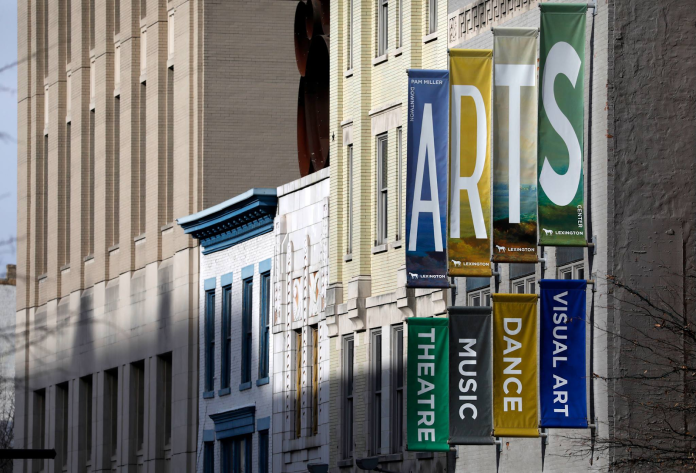I had the opportunity to learn about the Pam Miller Downtown Arts Center (DAC) in my Writing for the Arts class. From my interview with Pam Miller DAC Director Celeste Lewis, I learned about why making a space for the arts is essential for our city. Another aspect of the interview that I recognized was the connections to the book “What Art Does” by Brian Eno. Many of the points made about the purpose of art and art spaces in the book relate to what we discussed in our interview. Celeste demonstrated to me the importance of art in our community, which reflects the ideas of Brian Eno and Bette Adriaanse’s book.
The Pam Miller Downtown Arts Center serves as a major art venue for the city of Lexington. They host numerous art-related events, including galleries, concerts, plays, and classes. When I asked about the purpose of the DAC, Celeste told me that they want to be a place where artists can have the space they need for their creative output. This reminded me of the chapter where Eno and Adriaanse discussed how art makes communities. In the same way, art allows people to connect and express their interests, so does a space like the Pam Miller DAC.
For example, in chapter 8 of “What Art Does,” Eno and Adriaanse state that “Art is one of the things that binds people together”. This quote reminded me of a moment in my interview when I asked Celeste about what needs to be done for the Pam Miller Downtown Arts Center to keep going. She called back to a moment during the COVID-19 pandemic when Pam Miller DAC and the arts in general were struggling to survive in an isolating period. Yet even in the bleakest of moments, the urge to make art persisted. She gave an example of how the Blackbird Dance group, a local dance group in Lexington, desperately wanted to perform, despite the restrictions. Pam Miller DAC allowed them to perform in the window of one of their gallery rooms because, as she stated, “they just needed to perform,” and they attracted an audience on the street. They called it “The Glass Box”, and it was successful.
This story highlighted two points for me: that art will always find a way to thrive and that it has the ability to connect people. The way Pam Miller DAC was able to provide space for art and draw an audience at that moment speaks to its success as an organization. It also relates to Eno and Adriaanse’s point about art’s ability to bring people together, as seen in Celeste’s example. A great aspect of the Pam Miller DAC is that it consistently provides a space for artists and for people to experience art, allowing them to bond in new ways through various forms of art. Even when circumstances are challenging for the arts, Pam Miller DAC will still be a place where art can flourish.
Another moment from my time with Celeste that reminded me of the ideas from Eno and Adriaanse’s book was when she told me, “Without art, your city is garbage.” This happened outside the interview, while we were taking the elevator as I was about to leave, yet it stuck with me. It was bold and thought-provoking, and it immediately reminded me of our book, “What Art Does.” Namely, in the eighth chapter, when Eno and Adriaanse state that “Art is that cloud; a reservoir of shared experiences that gives us ways of sharing complex feelings and ideas with each other. It’s the lifeblood, the lubricant, the circulatory system, of community” (Eno and Adriaanse). The authors are trying to convey that art is an essential feature of humanity, society, and the foundation of community.
What Celeste said succinctly summarizes this point about the importance of art. She explained it to me with the example of a business moving into a new city. One of the first things they ask about is, “What’s the art scene like?” This example demonstrates two key points: that there is an economic incentive for art and that art makes things more interesting. Celeste pointed out that no one wants to live somewhere that’s boring. People want to live where there are fun things to do, and art is a major outlet for doing so. We love art, whether we consciously acknowledge it or not. It’s so important to us that we wouldn’t want to live somewhere without it. This is exactly what Eno and Andriaanse mean when they say art is the lifeblood of community. It’s the glue that holds our society together.
A final point of reflection on Pam Miller Downtown Arts Center and “What Art Does” is how the DAC is constantly evolving, just as the arts do. In chapter 9, when discussing the unfinished nature of art and building a better world, Eno and Adriaanse state that “As artists, we don’t finish it: we start it. It goes on to have a life without us, a life we didn’t predict” (Eno and Adriaanse). The point of this quote is to demonstrate the idea that we approach art and our lives as an ever-changing process, constantly building and rebuilding ourselves. Pam Miller DAC exemplifies this by consistently hosting new events, implementing renovations, and improvising in moments of need, as seen in the “The Glass Box” example. Pam Miller DAC, like any art organization, must be prepared to adapt to change when necessary. Celeste discussed this when I asked about what someone who wants to work in the arts can expect. She mentioned that while it’s very rewarding, it also requires having an incredible amount of energy because, as she said, “no two days are the same.” This attitude at Pam Miller DAC exemplifies Eno and Adiaanse’s point on the unfinished approach we should take in life, as they are prepared to tackle the challenges of being an arts organization through their capacity to adapt to change.
From my time with Celeste at the Pam Miller Downtown Arts Center, I not only learned a great deal about them, but also how Eno and Adriaanse’s ideas come to life in the arts. After meeting with Celeste, I found that Eno and Adriaanse have the right idea about the arts and their role in society.



